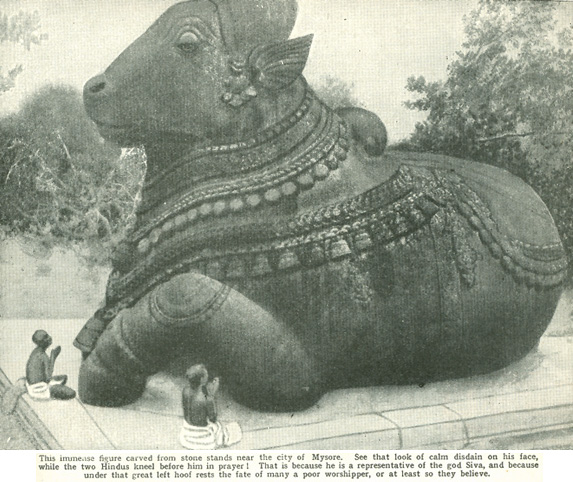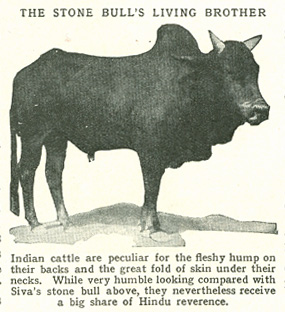
India’s rich plains region are the Punjab or " Land of the Five Rivers," Rajputana, the provinces of Oudh and Agra, the Bengal district and Assam.
A HOME ON THE MOUNTAIN BORDER

India’s rich plains region are the Punjab or " Land of the Five Rivers," Rajputana, the provinces of Oudh and Agra, the Bengal district and Assam.
The third division of India, the peninsula known as the Deccan, offers a marked contrast to the northern plains. The hill country begins not far south of Delhi, and spreads fan-wise south-east and south-west; while farther south a series of ranges crosses the peninsula from west to east. Close to the coast as they are, the Western Ghats form the true backbone of India; for from their rugged sides the whole country slopes generally eastward; the rivers which rise in their narrow landward gorges flow for the most part clear across the peninsula and empty into the Bay of Bengal. The Eastern Ghats, on the other hand, are of no very great altitude, for they average less than 1,000 feet. They are broken through in a great number of places by rivers, both large and small, which cut deep gashes to the sea.
The central Deccan consists principally of rough hills, some covered with dense forests, others with tall jungle grass, and still others swept bare by dry winds. At intervals are broad well-cultivated plateaus, and the banks of the numerous streams are dotted with tiny irrigated farms and cleared pasture lands. The political divisions of southern India are more, confused than are those of the north. The Bombay Presidency includes the Sind region and more than 350 small native states. Its chief city is Bombay, the second largest in India. East of the Bombay Presidency lie the native states of the Central India Agency and the Central Provinces under direct British rule. The cities of Gwalior in the north and Nagpur in the south are the most important. Farther south and occupying the very heart of the Deccan are the dominions of the Nizam of Hyderabad, the largest and most populous of the native states.
 INDIAN ART
INDIAN ART
On the left is the famous carved gate at Bhilsa. It dates back many centuries before the Christian era, and is considered one of the finest specimens of Buddhist art. This gateway stands at one of the four entrances of the Sanchi Tope, the oldest historical ruin in India. The second picture shows the pillars in a Delhi temple. Such carving is typical of Hindu art.
The Madras Presidency, the largest of the British provinces, begins south of the Bengal district, includes the whole east coast to Cape Comorin, and extends to the west coast, almost completely surrounding the large native state of Mysore (capital. Bangalore), and crowding the states of Cochin and Travancore into the south-west comer. This region, especially the Carnatic, is rich in historic traditions. The city of Madras is the third largest in India, and extends for some distance along the Coromandel coast; while among the other important places may be mentioned Madura, Trichinopoly, Calicut, Mysore, Nagapatum and Cuddalore.
The monsoons are the salvation of the millions in India who live on the fruits of the soil. There are two of these winds, the "great" or south-west monsoon, which blows from June to October; and the "lesser" or north-east monsoon, which blows during November and December. A good monsoon season means plenty of food for India, a bad monsoon means starvation, misery, and death fo thousands of helpless victims.
"great" or south-west monsoon, which blows from June to October; and the "lesser" or north-east monsoon, which blows during November and December. A good monsoon season means plenty of food for India, a bad monsoon means starvation, misery, and death fo thousands of helpless victims.
In general, southern India enjoys a more equable climate than the river plains or mountain regions. The latter are subject to extremes of heat and cold, dryness and moisture. In the Sind and the Thar desert are places where day after day in the summer the thermometer reaches F. IIO° in the shade, and a variation of 70° in a day is not uncommon.
The scourge of malaria and other "Indian fevers" claim a greater number of victims each year than all other causes, including even cholera and plague. Europeans during the hottest weather usually seek the high altitudes of Simla, Cashmere, and elsewhere.
The Himalayan climate is favourable to a tremendous variety of plant life. Below the snow line are to be found vast fields of rhododendrons, then thick forests of evergreens, and on the damp lower slopes to the east a rank and tangled undergrowth of coarse grass, bushes, cane-brakes, bamboo, and great trees, whose branches are thick with orchids.

A Region Rich in Fruits and Woods
The plains region is notable for the babul, a species of acacia, the mango, the banyan, the plantain, and the betel-palm. The northern Deccan forests consist chiefly of scrub trees, but in the south teak, sandalwood, and satinwood nourish abundantly.
Wild animals abound all over India, for religion forbids the majority of the people to kill any living creature. The tiger is found in all the wilder forest regions, and is responsible for about 500 deaths a year throughout the empire. Lions, once plentiful in Hindustan, are now confined to the Kathiawar peninsula between the Gulf of Cutch and the Gulf of Cambay. Bears are numerous in the mountains, and leopards infect many of the more remote tracts. Elephants still exist in the primeval forest's of the south-west, but the ranks of the domestic elephants are mainly recruited in the hills of Assam and Burma, where dwells also the rhinoceros.
The gaur or Indian bison, the wild buffalo, and the wild pig offer exciting sport to the hunter. The wolf, the jackal, the wild dog, and the striped hyena are
plentiful. Monkeys are numerous near settlements, and do great damage to crops. The larger rivers are filled with crocodiles: snakes abound in all districts, the cobra and the krait being the most dangerous, and causing thousands of deaths annually. Insects are incredibly numerous. A few, such as the bee, the silkworm, and the lac-insect, are encouraged for their useful products.
Continue to next page